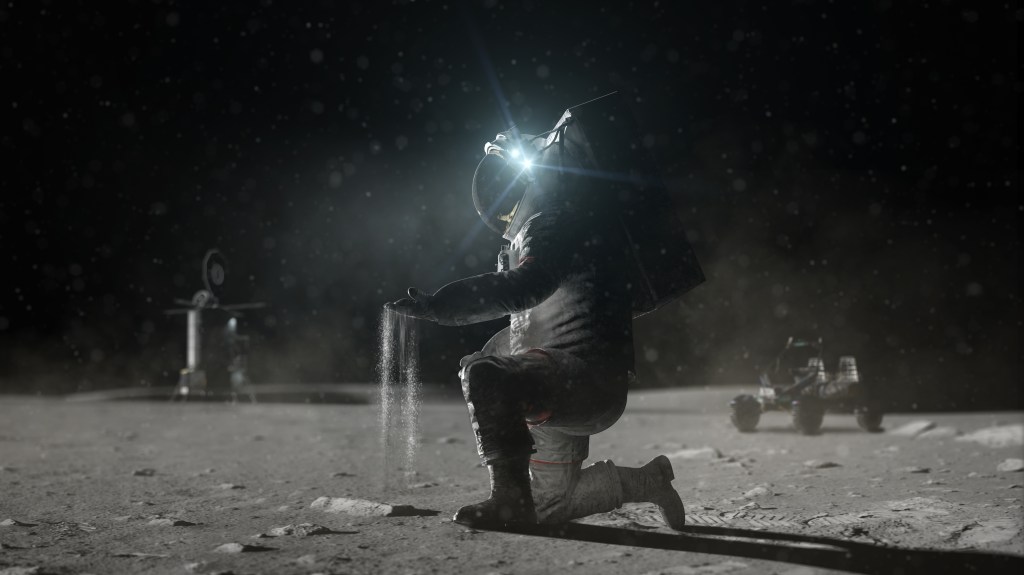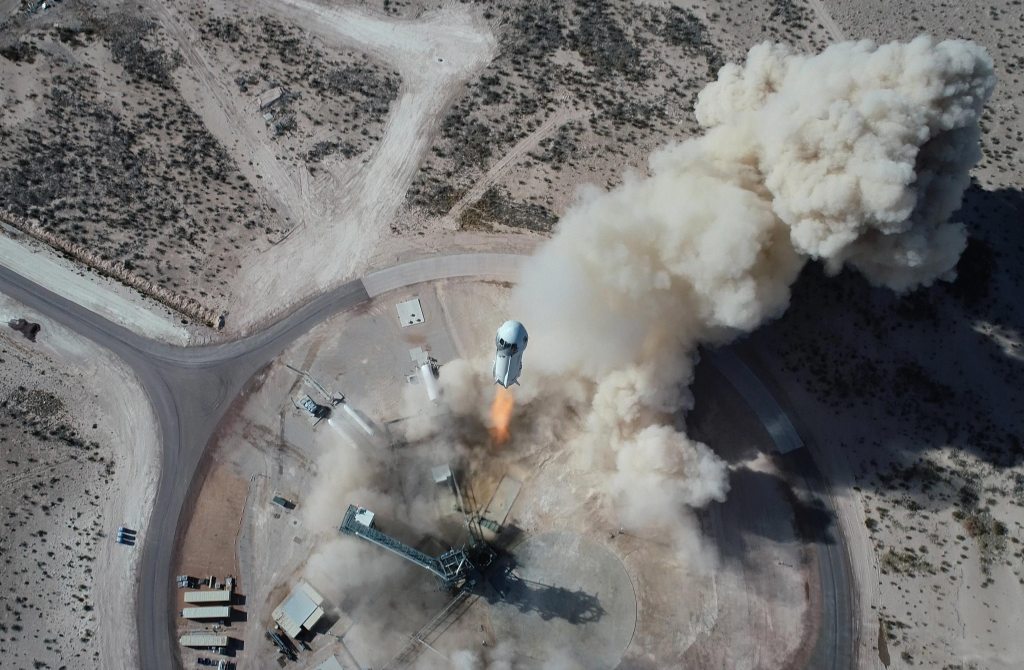Seventeen technologies are expected to fly aboard Blue Origin’s New Shepard reusable suborbital rocket system on an upcoming flight test. The flight will provide approximately two minutes of simulated lunar gravity, allowing researchers to test and de-risk innovations that could address critical shortfalls for the Artemis program, planetary exploration, and commercial space missions.
Vehicle capability enhancements to enable the simulation of lunar gravity during suborbital flight were supported by development funding and early purchase of payload space by NASA’s Flight Opportunities program as part of its strategic investment in the U.S. spaceflight industry.
Flight Provider
Blue Origin
Flight Test Platform
Reusable suborbital rocket system
Flight Date
TBA
Location
West Texas Launch Site
NASA’s Flight Opportunities program provided support for the flight testing of all payloads listed on this page. Payloads fall under these categories:
In-Situ Resource Utilization | Dust Mitigation | Advanced Habitation Systems
Sensors and Instrumentation | Small Spacecraft Technologies | Entry, Descent, and Landing
Game Changing Development (GCD) Animation | Related Stories

Asteroid Soil Strength Evaluation Tool (ASSET)
Researchers with Honeybee Robotics are utilizing this flight to calibrate ASSET, a simple dual-plunger sealed system and load cell to determine regolith resistance to penetration. By increasing knowledge of surface behavior and regolith strength of near-Earth asteroids in microgravity, they hope to reduce risks associated with asteroid missions.

Electrodynamic Regolith Conveyor
Researchers at NASA’s Kennedy Space Center are assessing a technology designed to move lunar regolith particles using dynamic electric fields generated by placing alternating high voltage on electrodes of the conveyor surface rather than conventional rotating or vibrating actuation. This dust-tolerant technology is designed to enable future in -situ resource utilization operations on the Moon. This technology is supported by NASA’s Game Changing Development program (see below).

Project Duneflow
Researchers from NASA’s Marshall Space Flight Center are quantifying gravity-dependent geotechnical properties (e.g., angle of repose) of various lunar regolith simulants to directly characterize and compare them under lunar gravity. Successful testing is expected to lead to simulants that effectively replicate flow behavior, potentially enabling better testing of excavation and regolith conveyance systems and thus leading to greater effectiveness of those technologies. This effort is supported by NASA’s Game Changing Development program (see below).

Vibratory Lunar Regolith Conveyor (VLRC)
Researchers at NASA’s Kennedy Space Center are investigating vertical transport of lunar regolith simulants under vacuum conditions. The VLRC takes advantage of a “stick-slip” phenomenon to overcome gravity-dependent static friction while conveying granular materials up an inclined surface. The payload enables simultaneous testing of several different lunar simulants for multiple pitches in the vertical screw conveyor design. This technology is supported by NASA’s Game Changing Development program (see below).

ISRU Pilot Excavator Bucket Drum Flow
Researchers at NASA’s Kennedy Space Center are assessing the performance of a bucket drum excavation technology for regolith collection. This technology allows regolith to be collected as the drums rotate in one direction and dispensed as they rotate in the opposite direction. On the Moon, these opposing rotations happen simultaneously to counteract excavation forces. The technology could enable low-mass robotic excavators to dig in the reduced gravity environments on the Moon and other planets. This technology is supported by NASA’s Game Changing Development program (see below).

Root-Like Burrowing Device
The University of California, Santa Barbara is assessing and comparing the reaction and anchoring forces of a non-rigid intruder, pneumatic tip-extending device. These tests seek to determine whether the tip-extending device could self-anchor and improve burrowing in microgravity where reaction forces are difficult to produce. Self-anchoring would enable the device to deliver subsurface sensors to deeper depths. Researchers are also evaluating the validity of using bed aeration to simulate reduced gravity on cohesive and non-cohesive lunar regolith simulants.

Honey Bubble Excitation Experiment (H-BEE)
Honeybee Robotics is testing a system to evaluate the physics of transporting granular material into bubbles formed within viscous material. Using honey as a viscous simulant for molten regolith and compressed gas for evolved oxygen, researchers aim to improve current methods of extracting oxygen from regolith, an important oxygen source on the Moon. The goal is to test extraction methods in lunar gravity using a safe, simple, and cost-effective platform.

SPARTA
Researchers from NASA’s Jet Propulsion Laboratory are testing a versatile, miniature, multi-tool instrument that can sense small concentrations of subsurface water and is designed to provide in-situ measurements of regolith densities as well as geomechanical, thermal, electrical, and chemical properties of dry or icy soils and permafrost on planetary surfaces. The robotically deployed payload is designed to emerge from a rover’s arm or body or from a lander’s footpad and take measurements at depths of up to 20 cm below the lunar or planetary surface.

PUFFER-Oriented Compact Cleaning and Excavation Tool (POCCET)
Honeybee Robotics is also testing this technology that uses a pneumatic technique to rapidly remove dust at a fractionally small mass. POCCET has the potential to remove dust from the surfaces of rocks, regolith-covered ices, solar panels, and sealing substances in order to allow accurate analysis of dust or regolith covered outcrops on the Moon or Mars.

ClothBot: Low-Gravity Transport of Dust Liberated from Spacesuit Fabric
NASA’s Glenn Research Center researchers are using a mechanical apparatus to autonomously stretch, shear, and crumple a patch of spacesuit material loaded with particles prior to launch. During the suborbital flight test, controlled fabric agitation causes the particles to shed. Researchers track the operation on video and measure the concentrations and size distributions of dust particles with miniature sensors. This effort is supported by NASA’s Game Changing Development program (see below).

Electrostatic Dust Lofting via Photoionization
With support from NASA’s Game Changing Development program, researchers at NASA’s Kennedy Space Center are conducting experiments involving photoionization of lunar regolith simulant grains and observing their electrostatic repulsion via high-speed imagery. Illumination by an ultraviolet lamp produces an effect similar to that of solar fluxes on the lunar surface. Researchers will compare results with previous laboratory findings to develop a gravitational scaling law. They will also enter the data into a dust charging and lofting model currently under development at the University of Colorado Boulder.

Hermes LunarG
To advance NASA’s understanding of regolith dynamics, dust settling, and granular mechanics, researchers from NASA’s Johnson Space Center are conducting four lunar dust mitigation and regolith characterization experiments. Using flight-proven hardware tested on the International Space Station, lunar simulants are released and allowed to settle in lunar gravity conditions. Optimized cameras and back-lighting capture data for post-flight analysis. With support from NASA’s Game Changing Development program (see below), these experiments aim to provide useful dust mitigation techniques needed for lunar exploration.

Material Flamability: Lunar-G Combustion Investigation (LUCI)
NASA’s Glenn Research Center researchers are also assessing the flammability of solid materials in lunar gravity. Observing the flame fronts of multiple samples at a variety of gravity accelerations, the payload records flame velocity images, radiant emissions, temperatures, and product gas concentrations. These moderate-duration flammability tests aim to provide guidance for rating the many materials anticipated to be used inside crewed spaces on the Moon, which will improve crew safety.

Multi-Phase Microfluidics for Chemical Analysis Systems
By coincidence, Earth’s Moon and Jupiter’s moon, Europa share nearly equal gravity. Researchers from NASA’s Jet Propulsion Laboratory are testing a sample handling technology to assess multi-phase reservoirs for sample mixing and bubble migration. The experiment apparatus utilizes the reservoirs’ shapes and a high-voltage electric field to help drive the gas phase to the desired location and prevent bubbles from blocking outlet/inlet channels. Testing the technology in relevant gravity conditions helps researchers test for the occurrence of unexpected phase behavior.

Flow Boiling in Microgap Coolers: Embedded Thermal Management
Embedded cooling of electronic devices could overcome several limitations of current techniques, and experimental validation of gravity-independent behavior could enable spaceflight systems to exploit this powerful thermal management technique. During this flight test, researchers from NASA's Goddard Space Flight Center are characterizing the fundamental fluid physics of two-phase flows in heated miniature and microscale channels.

FEMTA Micropropulsion
Researchers from Purdue University are testing FEMTA, a non-toxic micropropulsion alternative for precision attitude control for small spacecraft missions. This technology uses water surface tension to provide highly tunable low-power attitude and thermal control and enable in-situ resource utilization for propellant and reduce overall small spacecraft mission costs.

Draper Multi-Environment Navigator (DMEN)
Draper Labs is testing the DMEN entry, descent, and landing solution designed to give crewed missions wayfaring and location data needed for safe and accurate lunar and planetary landings. At 3 kg, DMEN consists of a suite of sensors (camera, inertial measurement unit, magnetometer), along with sensor circuitry, a computer, and algorithms to process sensor data for navigation. Its size, weight, and power requirements have the potential to benefit future NASA missions and the space industry.
Testing Dust Mitigation Technologies
Supported by NASA’s Game Changing Development program, seven payloads focus on enabling a safer sustainable presence on the Moon by mitigating the effects of lunar dust. Lunar dust is made of crushed rock and is damaging to everything from lunar landers to spacesuits and human lungs if inhaled. With the payload demonstrations on this flight test, researchers hope to learn how dust mitigation technologies work in a lunar gravity environment.
Watch the animation video at right to see these payloads in action.







































